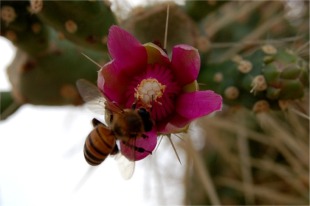Ever wonder how plants in the desert get pollinated? Although there aren't a great amount of honeybees in desert areas, there are many species of native bees that live in arid regions.
“Pollen” bees, also called native or solitary bees, are the main pollinators of plants in the world. They tend to be out and active in the early spring, before honey bees (which were imported to the Americas from Europe), and are very efficient pollinators.
Honeybees, which are also great pollinators, are generally raised for honey, while pollination is a byproduct.
In recent years, both native bee species and honeybee populations have been decimated because of the Varroa mite, and because of pesticides and habitat destruction.
Extensive use of pesticides, not only on farmland, but also in suburbia, has had a serious effect on all types of bees. It’s not widely known, but even natural herbicides and botanical pesticides can cause serious harm to bees.
Besides honeybees, and Africanized bees (simply another, albeit more aggressive strain of the domestic honeybee), there are a number of greatly beneficial native bees.
Digger bees, mining bees and sand bees are solitary ground-nesting bees.
Bumblebees, on the other hand, are social creatures.
Sweat bees are small, blackish or brownish bees, although a few species are greenish. As the name implies, they will sometimes land on your arm or neck to sip sweat. They are gentle and will not sting unless you swat them.
Alkali bees are native to the North America west of the Rocky Mountains. They are solitary and are black, with metallic-looking bands of yellow, blue or green circling the abdomen. They pollinate alfalfa, onions, clover, mind and celery.
Leafcutter bees are extraordinarily efficient pollinators. About 150 of them can do the pollination work of 3,000 honeybees.
Carpenter bees are some of the largest bees in the world. They can range in color from blue-black, purple or a greenish sheen. They drill circular holes in wood, and can tend to be annoying because of their tendency to buzz around. They are, however, generally harmless. The females do have a stinger, but they rarely use it.
Certain types of flowers attract all species of bees more than other types of flowers. Flowers which bees find particularly attractive include those that are:
- Full of nectar
- Since bees cannot see the color red, flowers that have petals that are brightly-colored and generally blue or yellow, or a mixture of these two colors.
- Aromatic or minty smell.
- Open in daylight
- Have platforms upon which the bees can land
- Generally symmetrical bilaterally
- Can be tubular with nectar at the base.
Related articles:
the image from www.edupic.net



0 comments:
Post a Comment